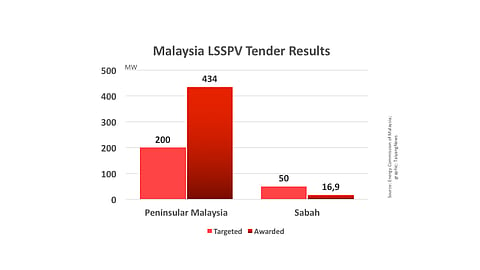Malaysia Awards Over 450 MW PV Capacity
- Malaysian Energy Commission has announced the winners for its large scale solar PV plants tender
- For Peninsular Malaysia, the targeted aggregate capacity was set as 200 MW, but the final list shows bids of around 434 MW
- As against the targeted aggregate capacity of 50 MW for Sabah region, the final tally came to 16.9 MW
- The capacity needs to come online by 2017-18
- The next bidding exercise, which is supposed to be published in the coming months, will have projects expected to achieve commercial operation date by 2019
The Energy Commission of Malaysia (EC) has announce the winners of its Large Scale Solar PV Plants (LSSPV) March 2016 tender. The capacity is supposed to come up in Peninsular Malaysia and Sabah regions of the country. Over 450 MW has been assigned to successful bidders under various packages.
The winners were decided on the basis of lowest levelized tariff and those who were able to meet all the requirements stated in the request for proposal (RFP). The selected projects are expected to achieve commercial operation date in 2017-18.
For Peninsular Malaysia, the capacity was divided into three packages – P1 (1 to 5 MW), P2 (6 to 29 MW) and P3 (30 to 50 MW). For Sabah region, there were two packages – 1 to 5 MW (S1) and 6 to 10 MW (S2).
In October 2016, EC published the price bids it received for LSSPV. The lowest tariff received for the P1 package in Peninsular came to RM 0.426 per kWh ($0.10) for 3.99 MW; RM 0.400 per kWh for 29 MW ($0.10) in P2, and RM 0.390 per kWh ($0.09) for 49 MW under P3.
For the Sabah/Labuan region, under S1 category, the lowest bid price was RM0.450 kWh ($0.11) for 5 MW, and for S2 the bids were RM0.508 per kWh ($0.12) for 6 MW.
Winning bidders will be expected to set up solar PV capacity between 1 to 50 MW per interconnection points on build, own and operate basis. The aggregated capacity target is 200 MW in Peninsular Malaysia and 50 MW in Sabah. Plants can be set up on land or on rooftops on land acquired by the developer. The maximum annual allowable quantity was to be proposed by the bidders based on the capacity of the plant.
Details about the winners, which are officially called shortlisted bidders, are available on the Energy Commission's website or here.
Malaysia plans to come out in the coming months with the next tender for which commercial operation is scheduled to be in 2019.


.png?w=50&fm=png)